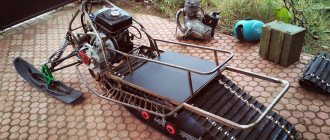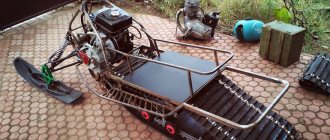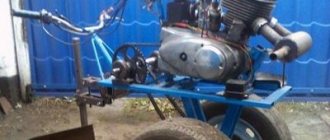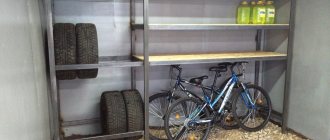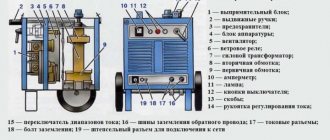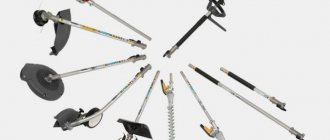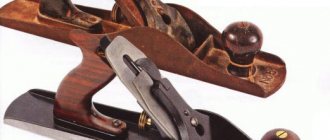Types of lifting devices
What the pulley for lifting loads and the construction crane have in common is the use of the idea of increasing force - the rule of leverage. In order to balance the load on the short side of the lever, you need to apply less force to its long side to the extent that the short arm is less than the long one. The ratio of forces at the ends of the lever is called the gear ratio.
You can balance and even lift a weight with an effort less than its weight, but the path made by the end of a long lever will be longer than that of a short one, just as less force was applied to lift it. There is no gain in work (F1*L1=F2*L2), but this is not required.
The use of Archimedes' principle is implemented in different lifting mechanisms, and how depends on the purpose of the lift. Designs differ in gear ratio, principle of force transfer, mobility, strength, and energy used. The most popular types for self-production:
- chain hoists;
- drum structures;
- lever mechanism.
To choose the type of device needed for specific work, it is worth familiarizing yourself with their capabilities and limitations.
The principle of operation of pulley hoists
The only simpler device for moving heavy objects is a metal scrap. The main element is a wheel with a chamfer in the middle of the outer surface, the axis of which is fixed to the ceiling beam. You can throw a hoist over it, and the lift with a gear ratio of 1 to 1 is ready. To increase the leverage, let's pass the hoist through another loose wheel, the axis of which is connected to the load, and fix the hoist at the top of the structure.
The transfer coefficient will become equal to 2 . Now let's attach another wheel to the ceiling, and pass the end of the hoist through it, securing it to the axis of the lower wheel. The gear ratio will become equal to 3. And so on, by adding one wheel at a time and changing the mounting location of the hoist, you can increase the gear ratio.
The location of the wheels relative to each other may be different.
The most compact designs are those with single-axle wheels. The design of such devices has two wheel holders. Having studied the drawings of the chain hoist, it will not be difficult to assemble it with your own hands. You will need two clips:
- traverse;
- carrying bracket;
- cheek for mounting parts;
- wheel (block);
- emphasis;
- bearing;
- sleeve;
- axis;
- axle holder;
- bearing oiler;
- hoist limiter;
- screw;
- bearing;
- cheek.
The end of the hoist is fixed to one of the clips.
Pulley hoists also have disadvantages. To increase the gear ratio by 1, you need to add one wheel each time, as a result the weight of the mechanism increases. In addition, bending the cable on each wheel requires force, reducing the efficiency of the device. You can reduce these losses by increasing the diameter of the wheels, but at the same time there will be an increase in the weight and dimensions of the pulley. Other types of lifts do not have these disadvantages.
We create a simple lifting mechanism with our own hands
Any construction site cannot do without effective and simple devices to facilitate labor and increase the speed and quality of the object being built. Today in this article I will talk about some of them, the simplest and most effective.
The easiest way to climb along guides, two ropes and fixed guides are enough for it.
This method is simple, but there are some tricks and difficulties; you need to pull at the same time and the guides must be securely fastened.
This is a very simple device, but it also makes the work easier, since the force is applied downwards, and this is always easier than simply pulling on the rope.
A lift in the form of a well crane perfectly reduces the time for lifting loads. The only negative is that. that lifting heavy loads using such a device is very difficult.
But lifting the load is much easier than without a counterweight.
Types of chain hoist fastenings
With the help of chain hoists, you can make your work several times easier. It all depends on the method of securing it.
If you apply fastening number 1, then the force will be equal to the weight of the load being lifted;
2- two times less than in the first case;
3 – three times less;
4 – four times less than in the first case.
With the help of a chain hoist you can lift a load without making much effort.
The figure shows the types and methods of fastening simple lifts with pulley blocks. Lifting mechanisms are made rotating and simple non-rotating.
To facilitate lifting, an electric drive is installed and beam cranes are installed. Such mechanisms completely replace a truck crane.
This is, of course, only a small part of all the devices and you can’t tell about them all in one article. So, wait for the continuation.
The most interesting and useful devices for construction
When building any object, be it a house or something else that requires lifting heavy objects to a height, you need to go in two ways.
The first and easiest way is to hire people to lift heavy materials such as mortar, concrete or something similar.
Second, make a lifting mechanism capable of lifting heavy loads.
This device can replace at least three people and it is made of an aluminum ladder and an electric hoist.
Such a lift is capable of lifting three buckets of concrete and can be used alone. It’s not difficult to make a welded frame on bearings, and anyone with a little knowledge of electric welding can easily attach an electric hoist to the top of a ladder.
If you attach the electric hoist as shown in the photo to a well-reinforced beam, then you will get a very convenient device that can easily replace a crane.
This simple device will speed up your work on grinding grooves when building from round timber. Using the same principle, you can make other devices for carpentry work.
Construction materials lift
Another useful homemade product that will make life at a construction site much easier is a building materials lift. For example, like the one from FORUMHOUSE member Ali-bastr
Having started pouring monolithic walls, the forum member got tired of manually lifting heavy buckets of concrete and made a simple but ingenious design.
The basis of the lift was a metal staircase.
To securely fix the ladder on the wall, in a 15×15 Ali-bastre
I drilled holes and put a washer on the back side of the pipe, securing it with a cotter pin.
The trolley on which building materials are placed moves up and down on bearings No. 304 using an electric winch. It is located almost parallel, at a slight angle to the stairs, due to which the movement occurs smoothly.
Types of lifting devices
What the pulley for lifting loads and the construction crane have in common is the use of the idea of increasing force - the rule of leverage. In order to balance the load on the short side of the lever, you need to apply less force to its long side to the extent that the short arm is less than the long one. The ratio of forces at the ends of the lever is called the gear ratio.
You can balance and even lift a weight with an effort less than its weight, but the path made by the end of a long lever will be longer than that of a short one, just as less force was applied to lift it. There is no gain in work (F1*L1=F2*L2), but this is not required.
The use of Archimedes' principle is implemented in different lifting mechanisms, and how depends on the purpose of the lift. Designs differ in gear ratio, principle of force transfer, mobility, strength, and energy used. The most popular types for self-production:
- chain hoists;
- drum structures;
- lever mechanism.
To choose the type of device needed for specific work, it is worth familiarizing yourself with their capabilities and limitations.
The principle of operation of pulley hoists
The only simpler device for moving heavy objects is a metal scrap. The main element is a wheel with a chamfer in the middle of the outer surface, the axis of which is fixed to the ceiling beam.
You can throw a hoist over it, and the lift with a gear ratio of 1 to 1 is ready.
To increase the leverage, let's pass the hoist through another loose wheel, the axis of which is connected to the load, and fix the hoist at the top of the structure.
The transfer coefficient will become equal to 2 . Now let's attach another wheel to the ceiling, and pass the end of the hoist through it, securing it to the axis of the lower wheel. The gear ratio will become equal to 3. And so on, by adding one wheel at a time and changing the mounting location of the hoist, you can increase the gear ratio.
The location of the wheels relative to each other may be different.
The most compact designs are those with single-axle wheels. The design of such devices has two wheel holders. Having studied the drawings of the chain hoist, it will not be difficult to assemble it with your own hands. You will need two clips:
- traverse;
- carrying bracket;
- cheek for mounting parts;
- wheel (block);
- emphasis;
- bearing;
- sleeve;
- axis;
- axle holder;
- bearing oiler;
- hoist limiter;
- screw;
- bearing;
- cheek.
The end of the hoist is fixed to one of the clips.
Pulley hoists also have disadvantages. To increase the gear ratio by 1, you need to add one wheel each time, as a result the weight of the mechanism increases.
In addition, bending the cable on each wheel requires force, reducing the efficiency of the device. You can reduce these losses by increasing the diameter of the wheels, but at the same time there will be an increase in the weight and dimensions of the pulley.
Other types of lifts do not have these disadvantages.
Manual drum winches
The principle of operation of winches resembles a simple lever fixed at a fulcrum. If the short arm of the lever is the surface of the cylinder, and the load is attached to it by a cable, you will get a winch with a gear ratio equal to the ratio of the length of the lever and the radius of the cylinder. To prevent reverse rotation, a ratcheting mechanism with a spring-loaded pawl is installed on the axis - a ratchet. You can assemble such a hand winch with your own hands according to the drawing:
However, the high gear ratio of the system will require a very long handle, which is inconvenient. The solution is found in two types of drum winches, which increase the gear ratio using gears or a worm gear.
How to make a winch with your own hands using a worm gear can be seen in the drawing:
A ratchet is not needed in this design; the gear ratio, when the worm flange passes over each gear tooth, is equal to the number of gear teeth multiplied by the ratio of the length of the handle to the radius of the worm. But a significant disadvantage will be the friction between the teeth and the comb. The mechanism requires constant lubrication.
A gearbox made of gears operates with much less friction. When using the principle of transmitting force through a pair of gears of different diameters, the easiest way to make a manual drum winch with your own hands is this:
Please note that a stopper is required in such devices. This design is used for small heights or lengths of cargo movement. A cable guide will help increase the movement distance by evenly distributing the cable along the length of the cylinder. The easiest way to get the result is to use a spring-loaded plate or rod that presses the cable to the drum:
How to make talcum powder with your own hands
A winch is an indispensable device both in the household and in the garage. Lift a roll of roofing felt onto the roof, throw a couple of bags of cement into the second floor window of a private house under construction, pull the engine out of the hood, and drag the broken car itself into the garage... This is an incomplete list of tasks that can easily be done alone with its help.
Drum-type devices for lifting or moving heavy objects differ in the way they transmit torque. From our school physics course we know how the shoulder works. Losing in speed or distance, we gain in strength. The phrase of Archimedes: “Give me a fulcrum, and I will turn the Earth upside down” precisely describes the principle of operation of the winch.
A manual winch, with the help of an attached shoulder, increases human strength so much that one operator can move cars or lift weights of several hundred kilograms. Although the principle of operation is the same (from a mechanical point of view), these devices have different methods of execution.
Manual drum winch - varieties
A hand winch with a drum is a classic of the genre. In addition to the common element - the pulley on which the cable is wound, the devices have different types of drive.
Single speed gear drive
A large, main gear is firmly attached to the drum. The entire load falls on it, and on the fastening. Therefore, the reliability of the elements must be at the proper level. In mesh with the main one, there is a small driving gear.
The ratio of the number of teeth is the value of the gear ratio. In other words, gain. The drive gear is integral with the drive shaft. Since we are talking about a hand tool, a handle is attached to the shaft for rotation.
The length of the lever also affects the degree of reinforcement. The larger the handle arm, the less effort you need to apply.
With the help of such devices, you can single-handedly lift several centners of cargo or move a car weighing 2-3 tons. At the same time, the rotation speed of the drum is quite high.
Multi-speed gear drive
The design consists of two or more pairs of gears, each of which has a gain of tens of times. With sequential engagement, these coefficients add up, multiplying the force.
The other side of the coin is a proportional reduction in speed. Having such a winch, you can slowly vertically lift loads of more than a ton, but if you have to work with two bags of cement, the lifting time will stretch for tens of minutes.
Therefore, manufacturers have provided the opportunity to use each pair of gears separately. By fixing the handle on a straight pair, we get medium force at high speed. By transferring it to the second pair, we lose speed, but double our strength.
A mandatory element of all manual winches is a stopper, or “pawl”
It works on the principle of a ratchet mechanism. After the force on the handle stops, the teeth of the sprocket rest against the stopper, preventing the cable from unwinding under the weight of the load. This improves safety, but the mechanism has a disadvantage.
It works perfectly when going up, but is completely useless when going down. During reverse rotation, the pawl is simply thrown to the side, releasing the ratchet.
Worm drive
To increase the force, a worm mechanism is used. The principle of calculating the transmission pair, compared to flat gears, is somewhat different, but the technique is the same. A small-diameter helical gear rotates the main gear mounted on the drum.
The advantage of the design is the high gain. Another plus is that the design is self-locking. That is, if you do not apply force to the handle, the machine will stop. This increases safety and comfort.
The handle can be rotated in any direction, lifting and lowering the load - without fear of it falling off.
A serious design flaw is the high friction in the worm pair. The mechanism needs constant lubrication, otherwise wear will be simply catastrophic. When working “dry,” the pair may simply jam.
Considering the mechanics of the process, there are restrictions on the weight with which you can work. But the tool turns out to be compact and is often used in the home.
Planetary reductor
With outstanding compactness (the gear mechanism is actually located inside the drum), the number of gear pairs can reach up to ten. The gain with this design can reach hundreds of times. The only drawback is the high cost of the product, so it is rarely used in everyday life.
Simplifying device assembly
At home, you can use improvised materials and ready-made transfer units. For example, the ratchet used in a KAMAZ vehicle to equalize the braking force is a ready-made worm gear mechanism.
You can get rid of manual lifting for a long time if you assemble the motorized winch system with your own hands for work once. To do this, you need to put a gear on the winch drive axis, connecting it with a chain to the chainsaw drive sprocket on a rigid housing structure.
By combining block mechanisms with drum winches, you can work to compensate for the shortcomings of each type of lift. For example, pulley hoists do not provide a lock that prevents reverse movement of the hoist, but drum swans eliminate this very simply. But the angle between the lifting force vector and the weight vector of the pulley can be almost anything, which winches cannot boast of.
You can use purchased lifts on the farm, but, as a rule, winches are needed where stores are far away - and always urgently. It's worth looking in the garage for some parts to get out of the situation.
Installation of lifting mechanism - manual or automatic
To mechanically lift loads onto the frame, you need to install a manual hoist - a worm winch and a cable. How to attach the hoist to the frame:
- on the side of the rack we install a manual worm winch (load capacity 800 kg, no less);
- The steel cable moves along rollers.
This mechanism makes it easy to lift the engine or car by the hood on one side.
You can use the lifting mechanism and rollers from the elevator door as a drive. The rollers there are reliable and durable.
An electric lift drive can also be installed on the manufactured base. A 300 - 500 W motor will be quite enough for simple repair work in the garage.
Such cranes are often used for the repair and reconstruction of old wooden houses. The construction of a log house will go faster if the logs are laid using a mobile homemade crane. In this case, the width of the frame is the length of the logs.
You can also make a simpler lift for the engine, on one support, watch the video.
The winch is one of the oldest devices that facilitates the movement of heavy objects, invented by man much earlier than he knew the laws of physics. The principle of operation of the winch is based on the rule of leverage: by applying minor forces to the handle, you can move and lift quite heavy objects. Winches and hoists are widely used on the farm for lifting building materials, dragging loads, and even for plowing land. Winches, powered by manual or electric drive, are also indispensable for lovers of off-road travel.
Buy a winch or make it yourself? Which winch design is better? The answers to these questions depend on how often you plan to use it and what loads you move. Manual winches require force but are not dependent on electrical power. An electric winch can move heavy loads without any effort on your part, but it must be powered or battery-powered. Below are the designs of several winches that you can make with your own hands; which winch to choose is up to you.
Gear manual hoists – is their popularity justified?
The main advantage of this type of hoists is considered to be simplicity of design and reliability. Many industries cannot do without them: neither in the construction, nor in the mining industry, nor in agriculture, nor in fuel and energy enterprises and others. Such a device can be used not only indoors, but also outdoors, even if there are no power sources. Moreover, such hoists are not only safe to use, but also unpretentious to use and have a durable mechanism.
The gear type of hoists is suitable for working with large loads weighing from 0.5 to 10 tons, and they can be lifted freely to a height of up to 12 m. A special load chain with a hook is designed for such a load, and the available additional drive chain will ensure not only good movement, but also easy movement of goods. You need to control the operation of such a hoist while standing on the ground. The action begins with the drive chain, this device is a stationary mechanism, and its purpose is to raise or lower loads from high shelves.
Monorails are installed indoors to move goods using hoists. Such stationary devices are usually used when there is no need to constantly move and lift loads. They are not designed for a large amount of work, and the movement speed is very low, this must be taken into account when choosing this tool. But at the same time, if you need to lift a fragile product or object, then these are the most successful hoists. Now we need to talk about the competitive model.
Lever hoist – advantageous physics of load capacity
This type of hoist is necessary for working with small loads, the weight of which is no more than 5 tons, and it can be raised to a height equal to the height of a person. It all depends on the design solution. Raising, lowering and moving is carried out using a lever built into the body. The hoist is controlled by an operator located near the device. Such models are good for tensioning cables and lifting loads. Since they are not suitable for a large volume of work, utility services find use for them.
They are necessary when you need to tension cables or install pipes at the bottom of trenches, as well as for installing hatches. With their help, foresters pull out stumps, and industrialists place heavy equipment in workshops. Often their purpose is to lift a load in order to work with it, which is how a jack works. This can be various repair work, for example, in car repair shops. To make working with lever hoists easier, they are additionally equipped with special trolleys.
Assembling the trolley for the hoist
First, let's prepare the necessary materials. You won't need very many of them, and most of them can be found in the garage. So, to assemble the cart we need:
- metal sheet 5 mm thick;
- rollers – guides and for the timing belt;
- corners;
- fasteners - nuts and bolts.
First you need to take a sheet of metal and cut out four identical rectangles from it. We drill four holes in each of them (as in the photo), and then weld them in pairs.
We get two blanks. They can be given the desired shape using a grinder. We weld an extended nut to the edges of each product to install the rollers.
We make a support shelf from the corner and weld it to one of the blanks. To make the finished product look attractive, we clean the welds and paint the parts.
Now you can proceed to the last stage - assembling the carriage. We attach rollers to the blanks - guides and for the timing belt, after which we fasten both parts. The finished trolley can be installed on a beam.
Having a little skill in working with metal, you can quickly design a trolley for a hoist. But you need to be completely confident in the reliability of the structure, since it will have to withstand quite a lot of weight.
Worm worm hoists - a compact strongman
In addition to these main types of manual hoists, there are also others. Lately, worm gear hoists are often used. To operate, they are hung stationary or a mobile “cat” is used. This is convenient for moving loads horizontally; such hoists can move along I-beams. There are a lot of models of this type of device. They are used for lifting or holding loads in a raised position; they are also suitable for moving. Everything happens along a special suspended track made of I-beam profile.
Their advantage is that work can be performed in small spaces, and the distance between beams and loads can be insignificant. Such hoists can also be used for work outdoors.
They have some features, for example, a rotating casing (and the design can rotate all 360 degrees) allows you to control work from anywhere, that is, you can raise and lower the load in any position. This creates additional safety; during operation, the operator can be located on the side of the hoists and also from the load itself. This type of hoist is also distinguished by its reliability, wear resistance and low-heating brake. All this makes them quiet and comfortable. And thanks to the low building height, you can work with this equipment in confined spaces in vertical positions.
DIY winch
The simplest winch for a garage that you can assemble yourself is a manual hoist. This design has many advantages:
- light weight and size;
- independence from power sources (unlike electric winches);
- low cost;
- possibility of improvement.
Article on the topic: How to name a car service in a garage
The disadvantages of the device include the need for physical effort. In addition, the chain hoist is inconvenient to use in difficult conditions (for example, in the cold, in mud or in confined spaces).
In order to assemble a simple winch with your own hands, you will need the following materials:
- a small piece of pipe;
- lever arm;
- axis of rotation;
- cable.
This device is very simple to make. First, a rotation axis is securely driven into the ground, onto which a piece of pipe is placed. A loop is made on the cable and secured to the axis of rotation so that when turning the cable is wound onto the axis. The second end of the cable will be attached to the object that needs to be moved. After installing the lever that rotates, you can use the device.
At first glance, it may seem that the device is not durable or effective enough, but you just need to test it in operation once and doubts will disappear by themselves. In the garage, a winch has always been and remains an indispensable assistant. Thanks to its versatility, you can lift or move even very heavy objects yourself. A winch, if necessary, will help you get out of difficult situations (for example, if your car is stuck).
How to make a manual hoist - step by step diagram
Step 1: Tools
First you need to purchase everything you need. You will definitely need three support poles, the length of which is about 4 meters and a diameter of about 12 cm, a metal rod with a diameter of about 12 cm, and there should be a thread at the end, several washers and M12 nuts, as well as a metal chain.
Step 2: Installation of nodes
First you need to drill holes in each post-pole. A rod is pulled into these holes, where there are threads at the ends. Washers are put on the ends and nuts are screwed on; they limit the divergence of the racks on the rods. Next, you need to fix the chain on the sides on the middle pole on the rod, and this is done using holes. The chain should slack a little, and a block with a cable is installed on it, and it should run along the middle post and be secured at the bottom.
Step 3: Activation
We place the stands on the ground at an angle of 120 degrees, then lift them up by the connecting nodes, and install everything like tripods. Then you need to move each stand in turn to the central part of the device, so you need to set the required height of the hoist and the cone of the tripod. The load that needs to be lifted should be attached to the cable and, when the gearbox rotates, torn off the surface.
How to make a hoist?
Share your drawings or just tips on how to properly make normal working talc. I need to roll out my YuMZ.
Share your drawings or just tips on how to properly make normal working talc. I need to roll out my YuMZ.
Hello. This is how I did it. Files: 039_4.jpg
In order to “tear” the YuMZ, you don’t need a hoist – you need paws. Paws made from 8 channels or 70 angles are screwed to the side members, a jack is placed under the flywheel housing and a long log is placed across the cross section of the rear linkage for the transmission and three people. One on a log keeps balance, and 2 sway (the rear wheels are on the kittens, but the front is fixed).
This is my homemade skill. Files: img_6513_.jpg
Or maybe use a gantry crane? I think it’s easier if you need it, I’ll send you a photo since it was done by eye; naturally, there are no drawings
This is my homemade skill.
Cool, can you be more specific about what it’s made of? And another photo. I seem to miss this little one.
My channel – https://www.youtube.com/user/pppatriot You are welcome to join the viber group “Farmers of Ukraine”, write in private.
This is my homemade skill.
Cool, can you be more specific about what it’s made of? And another photo. I seem to miss this little one.
Judging by its appearance, this talc is made from a KAMAZ ratchet (for releasing brakes). Load capacity approx. tons. Are you not satisfied with chain hoists? There are up to 10 tons, and this is not a small amount at home, and their price is not that high. Try to steer the search. Good luck
This is my homemade skill.
Cool, can you be more specific about what it’s made of? And another photo. I seem to miss this little one.
Adjusting lever of KamAZ brake mechanisms In the lever body there is a worm gear 3 (Fig. 4.6), mounted on the expansion fist shaft, and a worm 5 with an axis 11 pressed into it. The worm axis 11 is locked by a ball 10, which fits into the holes on the worm axis, and it is pressed by a spring 9, resting against the locking bolt 8. When turning the square end of the axis 11, the worm turns the gear 3 When it was necessary to do a major overhaul on the engine, they solved the problem with such an adjustment lever. Convenient, you can attach it to the car everywhere if necessary, I even took it out of the car once. Here are a few more photos, if you need more, I’ll take more.
Screw the racks with rollers to the side members like a trolley. Lay a channel under the rollers. Between the struts, a jumper with a bolt in the center is welded under the flywheel housing. We place a jack under the bridge. unscrew the bolts and roll the entire front end forward to the desired position (on 4 wheels)
This is my homemade skill.
Cool, can you be more specific about what it’s made of? And another photo. I seem to miss this little one.
Adjusting lever of KamAZ brake mechanisms In the lever body there is a worm gear 3 (Fig. 4.6), mounted on the expansion fist shaft, and a worm 5 with an axis 11 pressed into it. The worm axis 11 is locked by a ball 10, which fits into the holes on the worm axis, and it is pressed by a spring 9, resting against the locking bolt 8. When turning the square end of the axis 11, the worm turns the gear 3 When it was necessary to do a major overhaul on the engine, they solved the problem with such an adjustment lever. Convenient, you can attach it to the car everywhere if necessary, I even took it out of the car once. Here are a few more photos, if you need more, I’ll take more.
What is the maximum load your talc will withstand?
This is my homemade skill.
Cool, can you be more specific about what it’s made of? And another photo. I seem to miss this little one.
Adjusting lever of KamAZ brake mechanisms In the lever body there is a worm gear 3 (Fig. 4.6), mounted on the expansion fist shaft, and a worm 5 with an axis 11 pressed into it. The worm axis 11 is locked by a ball 10, which fits into the holes on the worm axis, and it is pressed by a spring 9, resting against the locking bolt 8. When turning the square end of the axis 11, the worm turns the gear 3 When it was necessary to do a major overhaul on the engine, they solved the problem with such an adjustment lever. Convenient, you can attach it to the car everywhere if necessary, I even took it out of the car once. Here are a few more photos, if you need more, I’ll take more.
What is the maximum load your talc will withstand?
system pressure up to 8 kg diaphragm diameter
16 cm, 3.14 * 8 * 8 * 8 in kg + our 3-fold safety margin, so 4 tons, if you have enough health to turn it, the gear ratio seems to be 1:20
This is my homemade skill.
Cool, can you be more specific about what it’s made of? And another photo. I seem to miss this little one.
Adjusting lever of KamAZ brake mechanisms In the lever body there is a worm gear 3 (Fig. 4.6), mounted on the expansion fist shaft, and a worm 5 with an axis 11 pressed into it. The worm axis 11 is locked by a ball 10, which fits into the holes on the worm axis, and it is pressed by a spring 9, resting against the locking bolt 8. When turning the square end of the axis 11, the worm turns the gear 3 When it was necessary to do a major overhaul on the engine, they solved the problem with such an adjustment lever. Convenient, you can attach it to the car everywhere if necessary, I even took it out of the car once. Here are a few more photos, if you need more, I’ll take more.
What is the maximum load your talc will withstand?
system pressure up to 8 kg diaphragm diameter
16 cm, 3.14 * 8 * 8 * 8 in kg + our 3-fold safety margin, so 4 tons, if you have enough health to turn it, the gear ratio seems to be 1:20
I don’t know if the design will withstand 4t, the engines were removed from the car without any problems
This is my homemade skill.
Cool, can you be more specific about what it’s made of? And another photo. I seem to miss this little one.
Technical description
A lifting hoist, also called a hoist, can be manual or electrically driven for automated use. According to technical characteristics, the equipment is a mechanism for lifting and moving various loads, including car parts.
The mobile trolley can be placed in any room, regardless of the available space and ceiling height. Depending on the type of design, the load capacity can reach 10 tons. A standard hoist is capable of lifting loads to a height of up to 12 m . The structure consists of the following elements:
- chain hoist, consisting of several blocks connected to each other;
- cylindrical coaxial gearbox;
- disc braking system;
- output shaft;
- hanger with hook.
How does a manually driven hoist work?
A hoist is a suspended lifting device. It can be manual or electric; the second option is, of course, more common. A hoist, in general, is a special mechanism for lifting or lowering various loads, as well as for moving them. The lifting capacity can be up to 10 tons, and objects can be lifted to a height of up to 12 m - you must admit, not bad for a manually driven mechanism.
Based on these indicators, this device can be used to move various heavy goods, these can be household appliances - gas stoves or refrigerators, freezers or washing machines, and the like. Trade workers often use them to put goods on shelves. You cannot do without manual hoists during construction or repair work, where you often have to lift building materials or tools .
An ordinary manual chain hoist has the following main elements: a chain hoist, consisting of movable and fixed blocks connected to each other; two-stage cylindrical coaxial gearbox, which has a manual mechanical drive; output shaft; specialized disc brake; additional load braking system; block pendant with hook. The operating principle is based on traction and load chain systems that have round links. The main types of manual hoists: gear and lever.
Where is it used?
The lifting device is used to move loads of various sizes and weights. These can be household appliances, metal structures and car parts. In production facilities, equipment is used to lift loads and place them on top shelves.
Manual hoists are widely used during repair and construction work, when there is a need to lift tools and heavy materials.
Varieties of hoist designs
There are several types of design that differ in installation method, design features, control option and other technical characteristics. When choosing the appropriate equipment option for a garage, it is necessary to take into account the individual needs and parameters of the room.
Manually driven
Hand hoists are used to lift objects to low heights. The lifting capacity of manually operated equipment varies from 1 to 8 tons. The traction force on the lifting mechanism is 30-65 kgf, which provides a speed of 0.3 to 0.1 m/min. The weight of the structure depends on the material and additional components and ranges from 50 to 400 kg.
Gear manual
Chain hoists with a gear mechanism are used to perform installation work within a garage or in open space. The equipment is controlled at the load securing point. Gear models are equipped with a hanging hook and are easy to install and operate. The design features of gear hoists allow them to be used as independent equipment or as a lifting element for cranes.
Lever
The manually operated lever hoist is equipped with a hanging hook and can be secured to support beams or wire rope. The manual operating principle ensures independence from the presence of electricity. The design provides a locking mechanism for fixing objects in a suspended state.
Worm
Worm hoists, by analogy with other varieties, are used to lift and lower loads. When equipped with additional elements, worm hoists can move objects along an I-section monorail track. You can hang a stationary hoist on a hook manually or make a complete version connected to a mobile trolley.
How to make a hoist for a garage with your own hands? — Handyman's Handbook
A suspended hoist in a garage is used as a lifting device. The equipment helps to move heavy objects and make car repairs more convenient. Armed with the necessary components, you can assemble the hoist with your own hands.
Technical description
A lifting hoist, also called a hoist, can be manual or electrically driven for automated use. According to technical characteristics, the equipment is a mechanism for lifting and moving various loads, including car parts.
The mobile trolley can be placed in any room, regardless of the available space and ceiling height. Depending on the type of design, the load capacity can reach 10 tons. A standard hoist is capable of lifting loads to a height of up to 12 m . The structure consists of the following elements:
- chain hoist, consisting of several blocks connected to each other;
- cylindrical coaxial gearbox;
- disc braking system;
- output shaft;
- hanger with hook.
Where is it used?
The lifting device is used to move loads of various sizes and weights. These can be household appliances, metal structures and car parts. In production facilities, equipment is used to lift loads and place them on top shelves.
Manual hoists are widely used during repair and construction work, when there is a need to lift tools and heavy materials.
Varieties of hoist designs
There are several types of design that differ in installation method, design features, control option and other technical characteristics. When choosing the appropriate equipment option for a garage, it is necessary to take into account the individual needs and parameters of the room.
Manually driven
Hand hoists are used to lift objects to low heights. The lifting capacity of manually operated equipment varies from 1 to 8 tons. The traction force on the lifting mechanism is 30-65 kgf, which provides a speed of 0.3 to 0.1 m/min. The weight of the structure depends on the material and additional components and ranges from 50 to 400 kg.
Gear manual
Chain hoists with a gear mechanism are used to perform installation work within a garage or in open space. The equipment is controlled at the load securing point.
Gear models are equipped with a hanging hook and are easy to install and operate.
The design features of gear hoists allow them to be used as independent equipment or as a lifting element for cranes.
Lever
The manually operated lever hoist is equipped with a hanging hook and can be secured to support beams or wire rope. The manual operating principle ensures independence from the presence of electricity. The design provides a locking mechanism for fixing objects in a suspended state.
Worm
Worm hoists, by analogy with other varieties, are used to lift and lower loads. When equipped with additional elements, worm hoists can move objects along an I-section monorail track. You can hang a stationary hoist on a hook manually or make a complete version connected to a mobile trolley.
How to make a homemade manual hoist: step-by-step instructions
When making a manual hoist yourself, just follow the step-by-step instructions. Equipment can be crafted by following these steps:
- Weld the faucet legs to the I-pipe.
- Position the metal corners at 45 degrees to create stiffening ribs that secure the rack. The bulk of the load being lifted falls on this rack, so for additional reliability, spacers need to be welded to it.
- If the hoist is mobile, rollers must be welded on each stand.
- Fix a pipe on the garage ceiling along which the lifting mechanism will move.
- Weld an I-beam in the center of the pipe to secure the roller mechanism.
- Insert the frame crossbar into the pipe.
- Drill through holes on both sides of the holder and fix the lifting mechanism.
Tools and materials
To build a hoist, you must first prepare a set of tools and components. In particular, to create a hoist you will need:
- an I-beam with a length of about 4-4.5 m (the exact length depends on the height of the ceiling in the garage);
- square pipe with dimensions 10x10 cm, 2 pipes with a diameter of 10-12 cm and a length of 2.5 m;
- Bulgarian;
- metal corners 10x10 cm;
- M16 bolts with nuts;
- lifting mechanism.
If you plan to install a mobile hoist, you will additionally need to use 4 rollers. The components are used to move the trolley.
Mounting nodes
One of the important stages in the construction of a mobile structure is the installation of components. First, you need to drill holes in the racks through which a rod with threads at the ends will be pulled. Washers are attached to the base of the rod and nuts are screwed on to limit the divergence of the posts. Then a chain is fixed on each side in the middle of the pole.
In order for the winch to move freely, there should be some slack in the chain. A block with a cable is installed on the chain, running along the middle pillar and fixed from the bottom.
Activation and performance testing
Before each start-up and operation of the hoist, it is recommended to check the functionality of the main elements. The following components are subject to inspection:
- Chain. Since the chain is responsible for holding the object at a height, it is important to check the load capacity. Periodic maintenance involves cleaning the chain from dirt and lubricating it with grease or similar materials.
- End chain. The element must be placed on the last loop.
- Top and bottom hooks. It is important to ensure that the hooks are intact and free of cracks, corrosion and other damage.
- Chain links. Mobile hoists must be stored in such a way as not to provoke twisting and bending of the links.
Preliminary testing of operability and compliance with equipment storage rules ensures stable operation without the risk of breakdown. Timely detection of problems with individual elements allows you to correct the breakdown and restore functionality.
Strengthening homemade lifting devices
Homemade lifting devices are currently becoming increasingly popular. During construction and when working in a garage, you often have to move heavy loads. In construction, manual transportation takes considerable time, and it is not always possible to install ramps or scaffolding. In any case, it is much easier and more efficient to use lifts.
Crane diagram
The same applies to the automotive theme; a garage with a lift is much more convenient to use. The simplest lifts are an ordinary beam, rigidly fixed at one end, and a movable block is installed at the other end. A rope is thrown over the block, with the help of which the loads are tightened manually.
Such a homemade lift is quite simple to manufacture, but from a practical point of view it is very inconvenient. Firstly, the load is still lifted manually, and secondly, dismantling and installing a beam from one place to another takes even more time than simply dragging weights. Similar mechanisms are used in log houses.
Construction of a log house
Materials and tools:
- pillar supports;
- wooden top beam;
- metal guide;
- wheel-pulley;
- bearings;
- chain hoist;
- spacers;
- pulley;
- welding machine.
If the question of how to make a lift for a log house yourself makes you think, then here is a fairly simple solution. An upper beam with a length slightly greater than the length of the future structure is installed on 2 vertically dug pillar supports. This gap makes it possible to drag logs directly from the stack to the installation site.
The wooden beam must be equipped with a metal guide on top along which the mechanism will move.
Further, the technology is simple: a wheel-pulley on a bearing is connected to an L-shaped metal part, to the other end of which a manual chain hoist with a load capacity of at least 750 kg is attached.
This minimum is explained by the fact that the weight of a thirty-centimeter-wide log house ranges from 270 to 400 kg, depending on the moisture content of the wood.
The pillars for such a structure must be at least 20 cm in diameter, and the beam, based on the load, is a beam of at least 15X20 cm in cross section.
The guide is a piece of reinforcement to which the tips of the nails are welded at equal distances, no more than half a meter. They will attach the guide to the wooden beam.
https://www..com/watch?v=KjtCHj_IMjg
The beam is fixed a couple of tens of cm away from the pillars to avoid coupling between the transport device and the pillar.
To strengthen the structure, spacers are installed on the nailed beam. If the height of the pillars is 4-5 m, then for stability they must be dug into the ground 1 m and spacers must be installed on the side in which the beam shifts.
The pulley, preferably with sides, is put on the guide and the lift is ready for work.
Homemade crane
During individual construction, you cannot do without a crane, which can also be made with your own hands if necessary.
A homemade crane will help install floors, foundations and all other structural elements, thanks to its ability to fall below the zero mark by 2.5 m and rise to a height of about 2 m.
How to make a homemade manual hoist: step-by-step instructions
When making a manual hoist yourself, just follow the step-by-step instructions. Equipment can be crafted by following these steps:
- Weld the faucet legs to the I-pipe.
- Position the metal corners at 45 degrees to create stiffening ribs that secure the rack. The bulk of the load being lifted falls on this rack, so for additional reliability, spacers need to be welded to it.
- If the hoist is mobile, rollers must be welded on each stand.
- Fix a pipe on the garage ceiling along which the lifting mechanism will move.
- Weld an I-beam in the center of the pipe to secure the roller mechanism.
- Insert the frame crossbar into the pipe.
- Drill through holes on both sides of the holder and fix the lifting mechanism.
Tools and materials
To build a hoist, you must first prepare a set of tools and components. In particular, to create a hoist you will need:
- an I-beam with a length of about 4-4.5 m (the exact length depends on the height of the ceiling in the garage);
- square pipe with dimensions 10x10 cm, 2 pipes with a diameter of 10-12 cm and a length of 2.5 m;
- Bulgarian;
- metal corners 10x10 cm;
- M16 bolts with nuts;
- lifting mechanism.
If you plan to install a mobile hoist, you will additionally need to use 4 rollers. The components are used to move the trolley.
Mounting nodes
One of the important stages in the construction of a mobile structure is the installation of components. First, you need to drill holes in the racks through which a rod with threads at the ends will be pulled. Washers are attached to the base of the rod and nuts are screwed on to limit the divergence of the posts. Then a chain is fixed on each side in the middle of the pole.
In order for the winch to move freely, there should be some slack in the chain. A block with a cable is installed on the chain, running along the middle pillar and fixed from the bottom.
Activation and performance testing
Before each start-up and operation of the hoist, it is recommended to check the functionality of the main elements. The following components are subject to inspection:
- Chain. Since the chain is responsible for holding the object at a height, it is important to check the load capacity. Periodic maintenance involves cleaning the chain from dirt and lubricating it with grease or similar materials.
- End chain. The element must be placed on the last loop.
- Top and bottom hooks. It is important to ensure that the hooks are intact and free of cracks, corrosion and other damage.
- Chain links. Mobile hoists must be stored in such a way as not to provoke twisting and bending of the links.
Preliminary testing of operability and compliance with equipment storage rules ensures stable operation without the risk of breakdown. Timely detection of problems with individual elements allows you to correct the breakdown and restore functionality.
Homemade manual hoist - a free household assistant
Often you have to carry out repair work at home, and you need to lift tools and materials. If you buy a manual hoist, it is expensive, and often you don’t have time. In this case, you can do it yourself.
A movable and simpler stationary crane beam in the garage with your own hands is quite doable if you have a welding machine and two days of free time. For a professional auto repair shop, it is easier to buy ready-made lifting equipment.
If the need for a crane is rare, then it is cheaper to make a simple and reliable lift yourself. Such a homemade crane can easily lift a weight of up to 800 kg, and this is quite enough for repair work in the garage.
In order to make a frame for a small beam crane in a standard garage with your own hands, you will need the following materials:
- I-beam (4 - 4.5 meters) - the required footage depends on the height of the garage;
- pipe (diameter 10-12 cm), length 2.4 meters - 2 pieces;
- one square pipe (10x10 cm);
- corners (10x10);
- manual hoist and hoist;
- bolts (M16) with nuts.
If you plan to build a mobile crane beam, then you need four more rollers and a hoist.
The procedure for making a crane frame with your own hands:
- We weld the legs of the crane - you need to weld the corners on both sides to the I-beam pipe;
- The location of the corner is at an angle of 45 degrees. The result is a kind of stiffening ribs that will firmly fix the stand, which bears the bulk of the weight of the load carried by the crane;
- We weld two triangles and spacers on each crane post.
- if the crane is a mobile beam, then on both sides from the bottom, on each stand, a roller must be welded horizontally - ordinary rollers for metal containers will do, furniture rollers will not withstand the weight;
- At the top, we fix a pipe as a crossbar along which the lifting mechanism will move;
- We weld an I-beam in the center of the pipe to secure the roller along which the steel cable of the crane’s lifting mechanism will move.
- We weld a piece of square pipe on top of the I-beam (to give rigidity to the frame) - 40 cm. The pipe should protrude on both sides by at least 20 cm. It turns out that the side post is located in the middle of the crossbar stiffening pipe;
- We insert the transverse pipe of the frame crossbar into the square pipe;
- We drill through holes for fastening bolts on both sides of the square holder and in the crossbar pipe itself - we need rigid, reliable fixation on both sides of the vertical post.
The result is a U-shaped structure of the crane frame, which is installed on rigid legs with spacers, and a crossbar pipe is rigidly bolted to the top.

